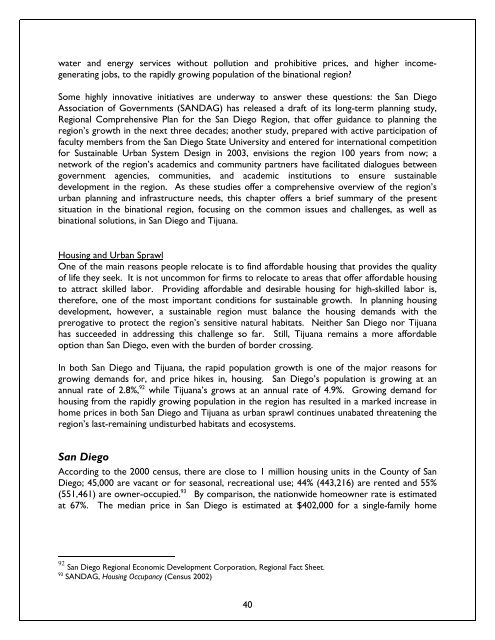Blurred Borders - International Community Foundation
Blurred Borders - International Community Foundation
Blurred Borders - International Community Foundation
Create successful ePaper yourself
Turn your PDF publications into a flip-book with our unique Google optimized e-Paper software.
water and energy services without pollution and prohibitive prices, and higher incomegenerating<br />
jobs, to the rapidly growing population of the binational region?<br />
Some highly innovative initiatives are underway to answer these questions: the San Diego<br />
Association of Governments (SANDAG) has released a draft of its long-term planning study,<br />
Regional Comprehensive Plan for the San Diego Region, that offer guidance to planning the<br />
region’s growth in the next three decades; another study, prepared with active participation of<br />
faculty members from the San Diego State University and entered for international competition<br />
for Sustainable Urban System Design in 2003, envisions the region 100 years from now; a<br />
network of the region’s academics and community partners have facilitated dialogues between<br />
government agencies, communities, and academic institutions to ensure sustainable<br />
development in the region. As these studies offer a comprehensive overview of the region’s<br />
urban planning and infrastructure needs, this chapter offers a brief summary of the present<br />
situation in the binational region, focusing on the common issues and challenges, as well as<br />
binational solutions, in San Diego and Tijuana.<br />
Housing and Urban Sprawl<br />
One of the main reasons people relocate is to find affordable housing that provides the quality<br />
of life they seek. It is not uncommon for firms to relocate to areas that offer affordable housing<br />
to attract skilled labor. Providing affordable and desirable housing for high-skilled labor is,<br />
therefore, one of the most important conditions for sustainable growth. In planning housing<br />
development, however, a sustainable region must balance the housing demands with the<br />
prerogative to protect the region’s sensitive natural habitats. Neither San Diego nor Tijuana<br />
has succeeded in addressing this challenge so far. Still, Tijuana remains a more affordable<br />
option than San Diego, even with the burden of border crossing.<br />
In both San Diego and Tijuana, the rapid population growth is one of the major reasons for<br />
growing demands for, and price hikes in, housing. San Diego’s population is growing at an<br />
annual rate of 2.8%, 92 while Tijuana’s grows at an annual rate of 4.9%. Growing demand for<br />
housing from the rapidly growing population in the region has resulted in a marked increase in<br />
home prices in both San Diego and Tijuana as urban sprawl continues unabated threatening the<br />
region’s last-remaining undisturbed habitats and ecosystems.<br />
San Diego<br />
According to the 2000 census, there are close to 1 million housing units in the County of San<br />
Diego; 45,000 are vacant or for seasonal, recreational use; 44% (443,216) are rented and 55%<br />
(551,461) are owner-occupied. 93 By comparison, the nationwide homeowner rate is estimated<br />
at 67%. The median price in San Diego is estimated at $402,000 for a single-family home<br />
92 San Diego Regional Economic Development Corporation, Regional Fact Sheet.<br />
93 SANDAG, Housing Occupancy (Census 2002)<br />
40















